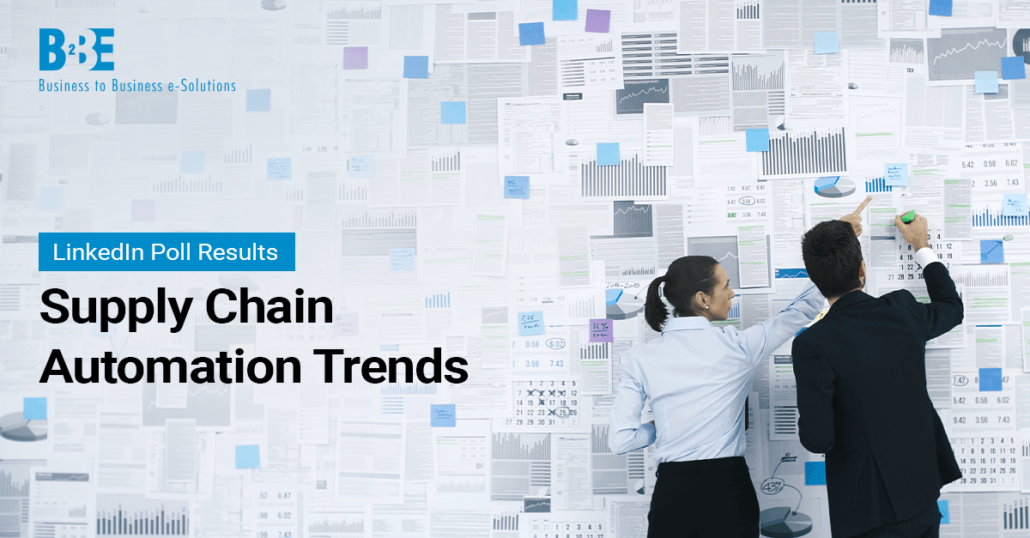In this blog post, we’ll explore the most important supply chain automation trends, as determined by our recent poll. We will review the results, examine the factors driving this trend, and discuss how it is likely to impact the industry going forward.
The rise of automation has revolutionised the supply chain industry in recent years. It allows companies to streamline their operations, reduce costs, and improve efficiency. With the increasing adoption of technology and data-driven solutions, the supply chain landscape is constantly evolving, and new trends emerge every year.
Poll results
In our most recent LinkedIn poll, we asked our social media followers: what supply chain automation trend will be most important this year?
Supply chain automation trends: what we found
Data Analytics – 45%
Data analytics has emerged as the most important supply chain automation trend of the year, according to our recent poll. In an era of digital transformation, data has become a critical asset for businesses to optimise their supply chain operations. By leveraging advanced analytics tools and techniques, companies can gain valuable insights into their supply chain performance. As well as identifying areas for improvement, and make data-driven decisions to increase efficiency and reduce costs. Moreover, data analytics can help companies predict demand, optimise inventory levels, and improve delivery times. All of which are essential for staying competitive in today’s fast-paced business environment. With 45% of respondents citing data analytics as the most important supply chain automation trend of the year, it is clear that businesses are recognising the transformative power of data-driven insights in driving supply chain success.
Hyper-automation – 30%
According to our recent poll, hyper-automation has emerged as the next most important supply chain automation trend of the year. 30% of respondents cited it as their top priority. Hyper-automation is the integration of advanced technologies such as artificial intelligence, machine learning, and robotic process automation to automate complex, end-to-end business processes. By automating multiple tasks across different functions and systems, hyper-automation can help companies reduce manual work. As well as improving operational efficiency and enhancing the customer experience. In the supply chain context, hyper-automation can enable end-to-end visibility. From order processing to delivery, enabling companies to track goods and manage inventory in real-time. With 30% of respondents recognising hyper-automation as a key trend in supply chain automation, it is clear that businesses are looking to invest in cutting-edge technologies that can transform their operations and enhance their competitive edge.
Digital Twins – 15%
Digital twins have emerged as the third most important supply chain automation trend of the year. That’s according to our recent poll, with 15% of respondents citing it as their top priority. A digital twin is a virtual replica of a physical object or system. It enables real-time monitoring and simulation of its performance. In the supply chain context, digital twins can help companies optimise their operations by providing a detailed view of their physical assets and processes. By leveraging real-time data from sensors and other sources, digital twins can help companies identify inefficiencies, optimise processes, and reduce downtime.
Moreover, digital twins can help companies simulate different scenarios and make data-driven decisions to improve their supply chain performance. With 15% of respondents recognising digital twins as a key trend in supply chain automation, it is clear that businesses are looking to leverage digital technologies to gain greater visibility and control over their supply chain operations.
Robotics – 10%
Robotics has emerged as our least selected supply chain automation trend of the year. That’s according to our recent poll, with only 10% of respondents citing it as their top priority. It involves the use of automated machines and equipment to perform repetitive or dangerous tasks in a supply chain environment. While robotics can improve efficiency and productivity in certain applications, it may not be the best fit for all supply chain processes. For instance, robotics may not be well-suited for operations that require a high degree of flexibility or customisation.
Moreover, robotics may be expensive to implement and require significant changes to existing infrastructure and workflows. With only 10% of respondents recognising robotics as a key trend in supply chain automation, it is clear that businesses are prioritising other areas, such as data analytics and hyper-automation, in their efforts to optimise their supply chain operations. However, robotics may still have a role to play in certain supply chain applications. It will be interesting to see how this technology evolves in the years to come.
Meer informatie
B2BE's ervaring in de toeleveringsketensector stelt onze klanten in staat met succes te bouwen, uit te breiden en zich aan te passen, waardoor een grotere effectiviteit mogelijk is. Om in contact te komen met B2BE en feedback te geven over wat voor u en uw bedrijf het belangrijkst is, kunt u het volgende doen volg ons op LinkedIn en via sociale media. U kunt ook Stem in onze laatste LinkedIn poll. Als u uw supply chain-strategie wilt bespreken, contact opnemen met ons.
